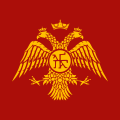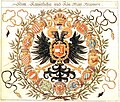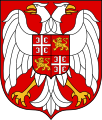Double-headed eagle: Difference between revisions
m Date maintenance tags: build 391:, |
|||
| Line 108: | Line 108: | ||
Image:Lascaris-Arms.svg|Coat of arms of the [[Laskaris]] dynasty |
Image:Lascaris-Arms.svg|Coat of arms of the [[Laskaris]] dynasty |
||
Image:Coat of Arms of Russian Empire.svg|[[National emblems of the Russian Empire|Coat of arms of the Russian Empire]] |
Image:Coat of Arms of Russian Empire.svg|[[National emblems of the Russian Empire|Coat of arms of the Russian Empire]] |
||
Image:Estandarte Imperial de Rusia.png|[[Flag of Russia|Flag of the Russian Empire]] |
|||
Image:ProvisionalGovt.gif|Coat of arms of the [[Russian Provisional Government|Russian Republic]] |
Image:ProvisionalGovt.gif|Coat of arms of the [[Russian Provisional Government|Russian Republic]] |
||
Image:Coat of Arms of the Russian Federation.svg|[[Coat of arms of Russia|Coat of arms of the Russian Federation]] |
Image:Coat of Arms of the Russian Federation.svg|[[Coat of arms of Russia|Coat of arms of the Russian Federation]] |
||
Revision as of 16:42, 22 January 2010
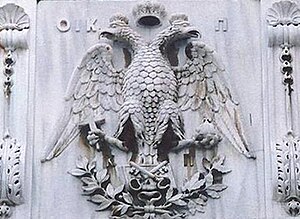
The double-headed eagle is a common symbol in heraldry and vexillology. It is most commonly associated with the Holy Roman Empire, the Byzantine Empire and the Vijayanagara Empire. In Byzantine heraldry, the heads represent the dual sovereignty of the Emperor (secular and religious) and/or dominance of the Byzantine Emperors over both East and West. Several Eastern European nations adopted it from the Byzantines and continue to use it as their national symbol to this day, the most prominent being Russia. However, the design was in use in the East for centuries before it was officially adopted by the Byzantines, and was independently adopted as the symbol of several other historical states, such as early medieval Armenia and the Seljuk Sultanate of Rûm[citation needed]. In Hindu mythology, the two-headed eagle is known as the Gandaberunda.
Origins
Double-headed eagles have been present in imagery for many centuries. The two-headed eagle can be found in the archaelogical remains[1] of the Hittite civilization dating from a period that ranges from the 20th century BC to the 13th century BC.
Cylindric seals discovered in Bogazkoy, an old Hittite capital in modern-day Turkey, represent clearly a two-headed eagle with spread wings. The aesthetics of this symmetrical position explains in part the birth of this religious figure. It probably dates from the 18th century BC, and was used in a tradesman background. It can also be seen in the same region in two monumental settings: in Alacahöyük around 1400 BC and in Yazilikaya before 1250 BC. Here the context looks different and totally religious: the eagle becomes a divinity symbol. The two-headed eagle slowly disappears during the last Hittite period, from the 9th century BC to the 7th century BC, and totally disappears after the end of the empire.
The double-headed eagle was also in use by the Arsacid Dynasty of Armenia and the Mamikonian family[2] in the 3rd to 9th centuries.
Byzantine Empire


Constantinople was the successor of Rome, and the Byzantines continued the use of the old imperial "single-headed" eagle motif. Although the roots of the transformation to double-headed are almost certainly connected with old depictions in Asia Minor, the details of its adoption are uncertain. It was, however, used in already during the first centuries AD and certainly before the 10th century AD by Armenians and Persians, appearing in their art (see above).
The Ancients used no flags in the modern sense. The Romans used various signa, such as the bronze aquilas (adopted as the legions' symbol by Marius) and vexilloids, and, if the emperor was present, pikes or banners with the emperor's portrait. With the adoption of Christianity as state religion during the later Empire, the Chi-Rho and the cross became more and more used in military standards, such as the labarum. The Roman single-headed eagle however continued to be used as a symbol of imperial authority.
According to the most prevalent theory, the single-headed eagle was modified to double-headed by emperor Isaakios Komnenos (1057-1059) being influenced from local traditions about such a beast (the haga) in his native Paphlagonia in Asia Minor. Local legends talked about this giant eagle with two heads that could easily hold a bull in its claws; the haga was seen as a representation of power, and people would often "call" it for protection. Isaakios Komnenos, deeply influenced by these beliefs, had already used it as a family emblem[3]. As there has been reference to "stone representations" of the eagle that were the inspiration for its picture, it is reasonable to assume that Hittite carvings may have been the sources of the myths themselves, but other relevant artwork cannot be excluded as such a source. Whether the eagle became an "imperial" symbol or remained purely a personal symbol for Komnenos, is not clear.
After the Latin conquest of Constantinople in 1204, the Byzantine double-headed eagle was used by the successor states of Epirus and Nicaea. Theodore II Laskaris chose it for his symbol as Emperor (Empire of Nicaea), taking it to symbolize his state's claims to all the Byzantine Empire's former domains, both European (West) and Asian (East). An alternative (and probably more correct) interpretation is that the eagle symbolized the Emperor's double temporal and spiritual sovereignty.[citation needed]
After the recapture of Constantinople and the restoration of the Byzantine Empire, the symbol was used as an emblem of the imperial family, but it is uncertain whether it was the official emblem of the Empire. More recent research has suggested that it was not, its usage being limited to imperial seals and other personal or dynasty symbols such as imperial robes, although there has been no depiction of any Emperor wearing it.[citation needed] The role of "state" symbols was most probably played by flags with the cross.[citation needed] In Byzantine usage, the eagle was almost always connected with colors of imperial power (gold and purple). A black eagle on golden background was used outside the imperial family, denoting the subordinate position (the eagle was black as being the 'shadow' of the Emperor's golden eagle) of their bearers.

Use by the Seljuk Turks (c.1058-1246)
The double-headed eagle became the standard of the Seljuk Turks with the crowning of Tuğrul (meaning "Falcon") Beg at Mosul in 1058 as "King of the East and the West" and was much used afterwards[citation needed]. The Sultans of Rum, Ala ad-Din Kayqubad I (1220-1237) and his son Kaykhusraw II (1237-1246) used the bicephalous eagle in their standards[citation needed], and the motif was also found on tissues, cut stones, mural squares, and Koran holders.[4]
Turcomans who ruled in Anatolia during the 13th century, inherited it from the Seljuk Turks. Islamic coins from the reign of Khalif Nasreddin Mahmoud bin Mohammad, following Turkish influence, sporting a double-headed eagle on one side and the Star of David on the other as early as year 1200.
Today, the Turkish Police have a double-headed eagle in its insignia as a secondary charge, in addtion to the Ataturk University in Erzurum, and two football clubs of Turkey, Erzurumspor and Konyaspor using it as their coat of arms.

Holy Roman Empire (c.1250-1806)
The first mention of a double-headed eagle in the West dates from 1250, in a roll of arms of Matthew of Paris for Emperor Frederick II of the Holy Roman Empire. Usually depicted black on a gold background, it replaced the earlier single-headed eagle, and was subsequently adopted in the coats of arms of many German cities and aristocratic families. After the dissolution of the Holy Roman Empire in 1806, the double-headed eagle was retained by the Austrian Empire, and served also as the coat of arms of the German Confederation.
Use by other countries

From Byzantium, two-headed eagles spread to Russia after Ivan III's second marriage to Zoe Palaiologina,[5] and to Montferrat, where a cadet branch of the Palaeologi ruled. It remains also an important motif in the heraldry of the imperial families of Russia (the House of Romanov) and Austria-Hungary (the House of Habsburg), as well as the royal family of Montenegro (the House of Petrovic).
It was the charge in the Coat of Arms of the Bulgarian Tsar Ivan Alexander (reigned 1331-1371). The Serbian Nemanjić dynasty adopted a white version as their own to signify their own independence of, and indeed, claim to the imperial throne of Constantinople. The white eagle was retained by most Serbian medieval dynasties, as well as the Karađorđević, Obrenović and Petrović-Njegoš houses and remains to this day in use in the coat-of-arms of the countries of Serbia and Montenegro. George Kastrioti (Skanderbeg) adopted a similar flag in his struggle against the Ottomans, consisting of a black eagle on red background, which has been resurrected in the current Flag of Albania. During the next centuries, the eagle was made to hold a sword and/or a sceptre and an orb with a cross, symbols of the aforementioned double sovereignty.

Its usage also survived as a decorative element in the Greek Orthodox Church, which was the inheritor of the Byzantine legacy during the Ottoman Empire, while it remained a popular symbol among Greeks. In modern Greece various variations of the two-headed eagles are used in Church flags (based on Byzantine flag patterns) and, officially, by the Greek Army (Coat of Arms of Hellenic Army General Staff). The bird found its way into the Greek coat of arms for a brief period in 1925-1926. [6] The two-headed eagle appears on the coat of arms of the following countries and territories:
- Albania (see Coat of arms of Albania)
- Armenia (see Coat of arms of Armenia)
- Austria-Hungary (historical)
- Austria (1934-1938) (see Coat of arms of Austria)
- Byzantine Empire (historical)
- German Confederation (historical)
- Holy Roman Empire (historical)
- Montenegro (see Coat of arms of Montenegro)
- Republika Srpska (formerly used from 1992 until 2007) in Bosnia and Herzegovina
- Russian Federation (see Coat of arms of Russia)
- Russian Empire (historical)
- Seljuk Empire (historical)
- Serbian Empire (historical)
- Serbia and Montenegro (historical)
- Serbia (see Coat of arms of Serbia)
- Spanish Empire during the House of Habsburg dynasty (see Coat of arms of Spain )
- Kingdom of Yugoslavia (historical)
It also appears on the following flags:
- Flag of Albania
- Flag of Montenegro
- State Flag of Serbia
- The flag of the Greek Orthodox Church, which is also used unofficially at the autonomous monastic state of Mount Athos
- Coat of Arms and flag of Hellenic Army General Staff. Also Coat of Arms and flag of Hellenic Army XVI Infantry Division.[7]
- With the addition of Greek letters "Ε Φ" or the label "ΕΘΝΙΚΗ ΦΡΟΥΡΑ" a similar coat of arms is used by the National Guard of the Republic of Cyprus.[8]
- The coat of arms of Bolsward, Netherlands
Use in Masonry
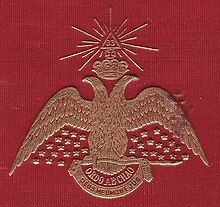
The Double-Headed Eagle of Lagash is used as emblem by the Scottish Rite of Freemasonry.[9] While there are many meanings attached to this symbol,[10] author M. P. Hall who wrote many works on the subject, suggested it an alchemical symbol of the union between the masculine and feminine principles in the individual.
Use in fiction
- In the world of Warhammer 40,000, the double-headed eagle forms the crest of the Imperium of Man, earning it considerable religious and cultural significance. For this reason, it is not too uncommon to create actual double-headed eagles through surgery, mechanical proxy or genetic manipulation. When these are used to aid the abilities of a psyker, they are known as psyber-eagles. The Emperor of Mankind is known to be from central Anatolia (currently Turkey), so it may be a reference to his geographic origins.
- In Namco's game, Tales of Symphonia, Aska, a golden, twin-headed bird who is one of the two Summon Spirits of Light is thought to have been inspired by the two-headed eagle.In Ragnarok Online the double-headed eagle appears ins many flags and buildings of the city of Prontera.
- In The Mouse That Roared and its sequels, the double-headed eagle is on the national flag of Grand Fenwick.
- In The Nightly News, a six-issue comic book mini-series by Jonathan Hickman (published by Image Comics), the Brotherhood of The Voice uses a double-headed eagle as one of their symbols.
- In the anime Beyblade, Claude from Barthez Battalion has a beyblade with the bit beast Rapid Eagle which is a two headed eagle.
- A roc appeared as a double-headed eagle in the film Sinbad's Seventh Voyage.
Use in sports
The double-headed eagle is the emblem of the Greek sport clubs A.E.K (black eagle on yellow background) and PAOK (black eagle on white background). It is a symbol of the clubs' origins, since both clubs were founded by Greeks who fled to Greece from Constantinople in 1922-23. It is also the emblem of the Turkish Konyaspor [1],the Dutch N.E.C. Nijmegen and the English non-League football club AFC Wimbledon.
Use in cults
The double-headed eagle was part of the emblem of the Order of the Solar Temple. This cult was started by Joseph Di Mambro and Luc Jouret in 1984 in Geneva. It gained notoriety in 1994 when members of the cult committed mass suicide and murders in two villages in Switzerland, followed in 1997 by suicide/murders in Canada.
Examples of double-headed eagle
-
Emblem of the Seljukians dynasty and the Great Seljuk Empire
-
Emblem of the Palaiologos dynasty and the Byzantine Empire
-
Coat of arms of a Holy Roman Emperor of the House of Habsburg
-
Coat of Arms of Charles I, during the Spanish Empire.
-
Coat of arms of the Austrian Empire
-
Coat of arms of the German Confederation
-
Coat of arms of the Laskaris dynasty
-
Coat of arms of the Russian Republic
-
(1992-2004) Coat of arms of Montenegro
-
The Seal of Skanderbeg
-
Emblem of 21. Waffen-Gebirgs-Division der SS „Skanderbeg“
-
Flag of the Greek Orthodox Church
-
Coat of arms of Lübeck
-
Coat of arms of Velletri
-
Coat of arms of the Province of Rovigo
-
In the upper right portion of Coat of arms of Armenia, there is a two-headed eagle, the emblem of the first dynasty to reign over a Christian Armenia, the Arsacid Dynasty of Armenia.
-
Coat of arms of Nijmegen
-
Hellenic Army General Staff[6]
-
Turkish National Police
-
A stamp with the Flag of Autonomous Epirus 1914
-
Coat of arms of Raffles Institution, Singapore's oldest school.
-
Coat of arms of the House of Montefeltro
-
Flag of Toledo, Spain
-
Coat of arms of the Serbian Nemanjić dynasty (12th c)
-
Armorial of Charles I of Spain
See also
References
- ^ Gallery.hd.org
- ^ ArmenianHeritage.com, "The Evolution of the Armenian Flag"
- ^ Zapheiriou, N. (1947). The Greek Flag from Antiquity to present. Athens, Greece. pp. 21–22.
{{cite book}}: CS1 maint: location missing publisher (link) - ^ A picture can be found in Titus Burckhardt, Art of Islam, under the chapter on the Rum seljuks.
- ^ Alfred Znamierowski (2003). Illustrated book of Flags. London: Southwater - Annes Publishing Ltd. p. 55. ISBN 1-84215-881-3.
- ^ a b Eleni Kokkonis-Lambropoulos & Katerina Korres-Zografos (1997). Greek flags, arms and insignia (Ελληνικές Σημαίες, Σήματα-Εμβλήματα) (in Greek). E. Kokkonis-G. Tsiveriotis. pp. 47, 51. ISBN 960-7795-01-6.
- ^ Army.gr
- ^ Army.gov.cy
- ^ Scottishritemasons-can.org
- ^ Altreligion.about.com
External links
- RF.Boom.ru, The development of the use of the double-headed eagle in Russia
- Heraldica.org, Page on the use of heraldry in the Byzantine Empire
- Metmuseum.org, Embroidered double-headed eagle on the podea of Paul, Patriarch of Constantinople (late 14th century) from the New York Metropolitan Museum of Art


